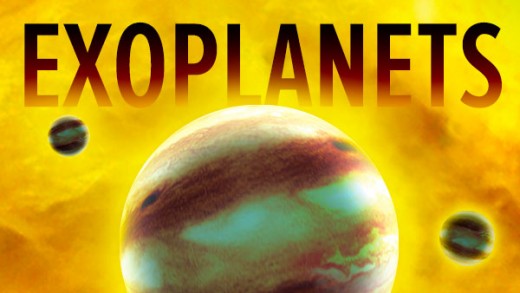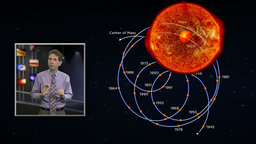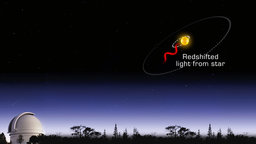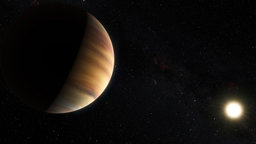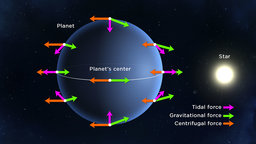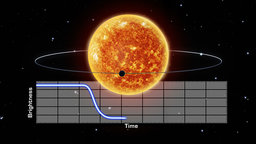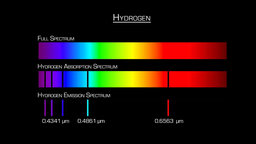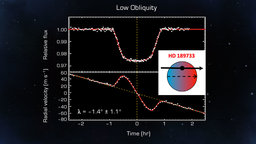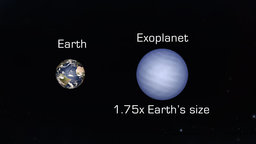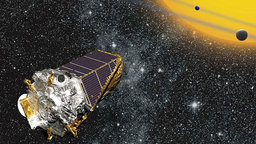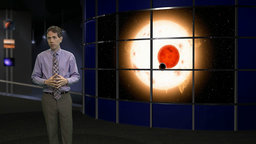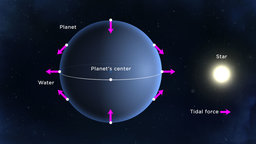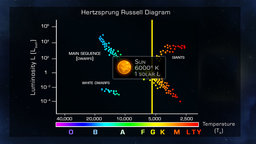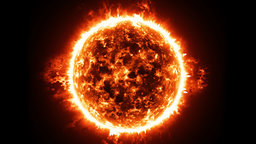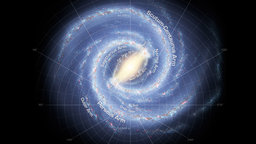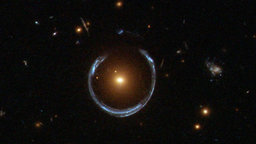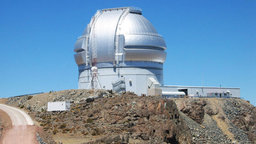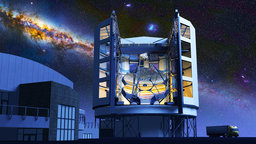Search for Exoplanets: Difference between revisions
No edit summary |
|||
| Line 9: | Line 9: | ||
== Episode 1 Why Study Exoplanets? == | == Episode 1 Why Study Exoplanets? == | ||
[[Image:exo_E1.jpg|left]] | [[Image:exo_E1.jpg|left]] My review...</br> | ||
<blockquote>''Learn about the exciting mission of exoplanetary science--the study of planets orbiting stars beyond the Sun. Review the eight planets in our solar system, which provide a baseline for understanding…''</blockquote> | <blockquote>''Learn about the exciting mission of exoplanetary science--the study of planets orbiting stars beyond the Sun. Review the eight planets in our solar system, which provide a baseline for understanding…''</blockquote> | ||
| Line 15: | Line 15: | ||
== Episode 2 How to Find an Exoplanet == | == Episode 2 How to Find an Exoplanet == | ||
[[Image:exo_E2.jpg|left]] | [[Image:exo_E2.jpg|left]] My review...</br> | ||
<blockquote>''Given the extreme faintness of a planet relative to the star it orbits, how can astronomers possibly find it? Learn about direct and indirect methods of detection. As an example…''</blockquote> | <blockquote>''Given the extreme faintness of a planet relative to the star it orbits, how can astronomers possibly find it? Learn about direct and indirect methods of detection. As an example…''</blockquote> | ||
| Line 21: | Line 21: | ||
== Episode 3 Doppler and Transit Planet-Finding Methods == | == Episode 3 Doppler and Transit Planet-Finding Methods == | ||
[[Image:exo_E3.jpg|left]] | [[Image:exo_E3.jpg|left]] My review...</br> | ||
<blockquote>''Explore two other indirect approaches for finding exoplanets: first, by measuring the Doppler shift in the color of a star due to the pull of an unseen orbiting planet; and…''</blockquote> | <blockquote>''Explore two other indirect approaches for finding exoplanets: first, by measuring the Doppler shift in the color of a star due to the pull of an unseen orbiting planet; and…''</blockquote> | ||
| Line 27: | Line 27: | ||
== Episode 4 Pioneers of Planet Searching == | == Episode 4 Pioneers of Planet Searching == | ||
[[Image:exo_E4.jpg|left]] | [[Image:exo_E4.jpg|left]] My review...</br> | ||
<blockquote>''Chart the history of exoplanet hunting--from a famous false signal in the 1960s, through ambiguous discoveries in the 1980s, to the big breakthrough in the 1990s, when dozens of exoplanets…''</blockquote> | <blockquote>''Chart the history of exoplanet hunting--from a famous false signal in the 1960s, through ambiguous discoveries in the 1980s, to the big breakthrough in the 1990s, when dozens of exoplanets…''</blockquote> | ||
| Line 33: | Line 33: | ||
== Episode 5 The Misplaced Giant Planets == | == Episode 5 The Misplaced Giant Planets == | ||
[[Image:exo_E5.jpg|left]] | [[Image:exo_E5.jpg|left]] My review...</br> | ||
<blockquote>''Investigate 51 Pegasi b, the first planet detected around a Sun-like star, which shocked astronomers by being roughly the size of Jupiter but in an orbit much closer to its…''</blockquote> | <blockquote>''Investigate 51 Pegasi b, the first planet detected around a Sun-like star, which shocked astronomers by being roughly the size of Jupiter but in an orbit much closer to its…''</blockquote> | ||
| Line 39: | Line 39: | ||
== Episode 6 Explaining the Misplaced Giant Planets == | == Episode 6 Explaining the Misplaced Giant Planets == | ||
[[Image:exo_E6.jpg|left]] | [[Image:exo_E6.jpg|left]] My review...</br> | ||
<blockquote>''The standard theory of planet formation is based on our solar system. But does this view require revision based on the existence of misplaced giant planets--hot Jupiters circling close to…''</blockquote> | <blockquote>''The standard theory of planet formation is based on our solar system. But does this view require revision based on the existence of misplaced giant planets--hot Jupiters circling close to…''</blockquote> | ||
| Line 45: | Line 45: | ||
== Episode 7 The Transits of Exoplanets == | == Episode 7 The Transits of Exoplanets == | ||
[[Image:exo_E7.jpg|left]] | [[Image:exo_E7.jpg|left]] My review...</br> | ||
<blockquote>''A tiny percentage of exoplanets can be detected transiting--or passing in front of--their host stars. Combined with Doppler shifts, transits provide information about a planet's size, mass, density, and likely…''</blockquote> | <blockquote>''A tiny percentage of exoplanets can be detected transiting--or passing in front of--their host stars. Combined with Doppler shifts, transits provide information about a planet's size, mass, density, and likely…''</blockquote> | ||
| Line 51: | Line 51: | ||
== Episode 8 Sniffing Planetary Atmospheres == | == Episode 8 Sniffing Planetary Atmospheres == | ||
[[Image:exo_E8.jpg|left]] | [[Image:exo_E8.jpg|left]] My review...</br> | ||
<blockquote>''Survey the history of spectroscopy to understand how a telescope and a diffraction grating can disclose the composition of a star and its planet. Then learn how transits and occultations…''</blockquote> | <blockquote>''Survey the history of spectroscopy to understand how a telescope and a diffraction grating can disclose the composition of a star and its planet. Then learn how transits and occultations…''</blockquote> | ||
| Line 57: | Line 57: | ||
== Episode 9 Stellar Rotation and Planetary Revolution == | == Episode 9 Stellar Rotation and Planetary Revolution == | ||
[[Image:exo_E9.jpg|left]] | [[Image:exo_E9.jpg|left]] My review...</br> | ||
<blockquote>''Trace Professor Winn's own search for the subtle signs that tell whether a star has a tilted axis. Discover why this is an important clue in the mystery of misplaced…''</blockquote> | <blockquote>''Trace Professor Winn's own search for the subtle signs that tell whether a star has a tilted axis. Discover why this is an important clue in the mystery of misplaced…''</blockquote> | ||
| Line 63: | Line 63: | ||
== Episode 10 Super-Earths or Mini-Neptunes? == | == Episode 10 Super-Earths or Mini-Neptunes? == | ||
[[Image:exo_E10.jpg|left]] | [[Image:exo_E10.jpg|left]] My review...</br> | ||
<blockquote>''Learn how a sensitive new instrument led the way in finding planets smaller than the Jupiter-sized giants that dominated the earliest exoplanetary discoveries. Halfway in size between Earth and Neptune,…''</blockquote> | <blockquote>''Learn how a sensitive new instrument led the way in finding planets smaller than the Jupiter-sized giants that dominated the earliest exoplanetary discoveries. Halfway in size between Earth and Neptune,…''</blockquote> | ||
| Line 69: | Line 69: | ||
== Episode 11 Transiting Planets and the Kepler Mission == | == Episode 11 Transiting Planets and the Kepler Mission == | ||
[[Image:exo_E11.jpg|left]] | [[Image:exo_E11.jpg|left]] My review...</br> | ||
<blockquote>''The planet search took a giant leap forward in 2009 with the launch of the Kepler spacecraft, which used the transit technique to observe nearly 200,000 stars over a four-year…''</blockquote> | <blockquote>''The planet search took a giant leap forward in 2009 with the launch of the Kepler spacecraft, which used the transit technique to observe nearly 200,000 stars over a four-year…''</blockquote> | ||
| Line 75: | Line 75: | ||
== Episode 12 Compact Multiplanet Systems == | == Episode 12 Compact Multiplanet Systems == | ||
[[Image:exo_E12.jpg|left]] | [[Image:exo_E12.jpg|left]] My review...</br> | ||
<blockquote>''Dig deeper into the treasure trove of data from the Kepler mission, which discovered hundreds of compact multiplanet systems, with planets much more closely packed than in our solar system.…''</blockquote> | <blockquote>''Dig deeper into the treasure trove of data from the Kepler mission, which discovered hundreds of compact multiplanet systems, with planets much more closely packed than in our solar system.…''</blockquote> | ||
| Line 81: | Line 81: | ||
== Episode 13 Planets Circling Two Stars == | == Episode 13 Planets Circling Two Stars == | ||
[[Image:exo_E13.jpg|left]] | [[Image:exo_E13.jpg|left]] My review...</br> | ||
<blockquote>''See how data from the Kepler spacecraft confirms a scenario straight out of the movie Star Wars: a planet with two suns. Investigate the tricky orbital mechanics of these systems.…''</blockquote> | <blockquote>''See how data from the Kepler spacecraft confirms a scenario straight out of the movie Star Wars: a planet with two suns. Investigate the tricky orbital mechanics of these systems.…''</blockquote> | ||
| Line 87: | Line 87: | ||
== Episode 14 Lava Worlds == | == Episode 14 Lava Worlds == | ||
[[Image:exo_E14.jpg|left]] | [[Image:exo_E14.jpg|left]] My review...</br> | ||
<blockquote>''Explore the theoretical limit of the smallest possible orbit for a planet, taking into consideration tidal stresses and other destructive processes. Then focus on Professor Winn's search for such objects,…''</blockquote> | <blockquote>''Explore the theoretical limit of the smallest possible orbit for a planet, taking into consideration tidal stresses and other destructive processes. Then focus on Professor Winn's search for such objects,…''</blockquote> | ||
| Line 93: | Line 93: | ||
== Episode 15 Earthlike Planets == | == Episode 15 Earthlike Planets == | ||
[[Image:exo_E15.jpg|left]] | [[Image:exo_E15.jpg|left]] My review...</br> | ||
<blockquote>''Begin your search for planets that may harbor life by studying the conditions that make Earth habitable, including its distance from the Sun, surface temperature, atmosphere, and oceans. Then examine…''</blockquote> | <blockquote>''Begin your search for planets that may harbor life by studying the conditions that make Earth habitable, including its distance from the Sun, surface temperature, atmosphere, and oceans. Then examine…''</blockquote> | ||
| Line 99: | Line 99: | ||
== Episode 16 Living with a Dwarf Star == | == Episode 16 Living with a Dwarf Star == | ||
[[Image:exo_E16.jpg|left]] | [[Image:exo_E16.jpg|left]] My review...</br> | ||
<blockquote>''The most common stars are class M dwarf stars, which are smaller and less luminous than the Sun (class G). Earth-sized planets are much easier to detect around M-dwarf stars,…''</blockquote> | <blockquote>''The most common stars are class M dwarf stars, which are smaller and less luminous than the Sun (class G). Earth-sized planets are much easier to detect around M-dwarf stars,…''</blockquote> | ||
| Line 105: | Line 105: | ||
== Episode 17 Living with a Giant Star == | == Episode 17 Living with a Giant Star == | ||
[[Image:exo_E17.jpg|left]] | [[Image:exo_E17.jpg|left]] My review...</br> | ||
<blockquote>''In billions of years, the Sun will expand into a red giant, possibly engulfing Earth. Learn how planet-finding techniques give astronomers insight into the processes inside giant stars. Then study…''</blockquote> | <blockquote>''In billions of years, the Sun will expand into a red giant, possibly engulfing Earth. Learn how planet-finding techniques give astronomers insight into the processes inside giant stars. Then study…''</blockquote> | ||
| Line 111: | Line 111: | ||
== Episode 18 Our Nearest Exoplanetary Neighbors == | == Episode 18 Our Nearest Exoplanetary Neighbors == | ||
[[Image:exo_E18.jpg|left]] | [[Image:exo_E18.jpg|left]] My review...</br> | ||
<blockquote>''Pinpoint the location of the nearest exoplanetary systems to Earth. First, get the big picture on the layout of our Milky Way galaxy, its size, and the Sun's position. Also…''</blockquote> | <blockquote>''Pinpoint the location of the nearest exoplanetary systems to Earth. First, get the big picture on the layout of our Milky Way galaxy, its size, and the Sun's position. Also…''</blockquote> | ||
| Line 117: | Line 117: | ||
== Episode 19 Finding Planets with Gravitational Lensing == | == Episode 19 Finding Planets with Gravitational Lensing == | ||
[[Image:exo_E19.jpg|left]] | [[Image:exo_E19.jpg|left]] My review...</br> | ||
<blockquote>''Get a lesson in Einstein's general theory of relativity to understand an effect called gravitational microlensing, which allows astronomers to deduce a planet's existence without recording any light from the…''</blockquote> | <blockquote>''Get a lesson in Einstein's general theory of relativity to understand an effect called gravitational microlensing, which allows astronomers to deduce a planet's existence without recording any light from the…''</blockquote> | ||
| Line 123: | Line 123: | ||
== Episode 20 Finding Planets with Direct Imaging == | == Episode 20 Finding Planets with Direct Imaging == | ||
[[Image:exo_E20.jpg|left]] | [[Image:exo_E20.jpg|left]] My review...</br> | ||
<blockquote>''Turn to the most obvious way to find exoplanets: direct imaging. Explore the optics of telescopes to learn why spotting an exoplanet next to its parent star is so difficult.…''</blockquote> | <blockquote>''Turn to the most obvious way to find exoplanets: direct imaging. Explore the optics of telescopes to learn why spotting an exoplanet next to its parent star is so difficult.…''</blockquote> | ||
| Line 129: | Line 129: | ||
== Episode 21 Near-Term Future Planet-Finding Projects == | == Episode 21 Near-Term Future Planet-Finding Projects == | ||
[[Image:exo_E21.jpg|left]] | [[Image:exo_E21.jpg|left]] My review...</br> | ||
<blockquote>''The success of exoplanetary science has spurred a wave of new projects to increase our knowledge of worlds beyond our solar system. Survey ground- and space-based programs that are now…''</blockquote> | <blockquote>''The success of exoplanetary science has spurred a wave of new projects to increase our knowledge of worlds beyond our solar system. Survey ground- and space-based programs that are now…''</blockquote> | ||
| Line 135: | Line 135: | ||
== Episode 22 Long-Term Future Planet-Finding Projects == | == Episode 22 Long-Term Future Planet-Finding Projects == | ||
[[Image:exo_E22.jpg|left]] | [[Image:exo_E22.jpg|left]] My review...</br> | ||
<blockquote>''Peer into the future at ambitious projects that may one day succeed in collecting light directly from an Earth-sized planet in the habitable zone of a nearby star. Examine three…''</blockquote> | <blockquote>''Peer into the future at ambitious projects that may one day succeed in collecting light directly from an Earth-sized planet in the habitable zone of a nearby star. Examine three…''</blockquote> | ||
| Line 141: | Line 141: | ||
== Episode 23 The Search for Life on Exoplanets == | == Episode 23 The Search for Life on Exoplanets == | ||
[[Image:exo_E23.jpg|left]] | [[Image:exo_E23.jpg|left]] My review...</br> | ||
<blockquote>''Join the quest for life on exoplanets, focusing on the search for extraterrestrial intelligence (SETI)--a hunt for signals from alien civilizations inspired by a landmark paper in 1959. See how…''</blockquote> | <blockquote>''Join the quest for life on exoplanets, focusing on the search for extraterrestrial intelligence (SETI)--a hunt for signals from alien civilizations inspired by a landmark paper in 1959. See how…''</blockquote> | ||
| Line 147: | Line 147: | ||
== Episode 24 Coming Soon: Biosignatures, Moons, and More! == | == Episode 24 Coming Soon: Biosignatures, Moons, and More! == | ||
[[Image:exo_E24.jpg|left]] | [[Image:exo_E24.jpg|left]] My review...</br> | ||
<blockquote>'Explore the distinctive biosignatures that show the presence of life of any kind on an exoplanet. Then close with Professor Winn's tip sheet on exoplanetary discoveries likely in the near…''</blockquote> | <blockquote>'Explore the distinctive biosignatures that show the presence of life of any kind on an exoplanet. Then close with Professor Winn's tip sheet on exoplanetary discoveries likely in the near…''</blockquote> | ||
Latest revision as of 14:58, 20 March 2019
As I mentioned on the main The Great Courses page, I haven't watched this show yet, but look forward to it. For now, here is the episode guide
The Search for Exoplanets: What Astronomers Know
This is the general description of the course/series.
Half a century ago, television viewers thrilled to the exploits of the original Star Trek series with its mission “to explore strange new worlds.” Today, astronomers are doing exactly that, analyzing the data from advanced telescopes and discovering strange worlds orbiting other stars in our galaxy.
Episode 1 Why Study Exoplanets?
My review...
Learn about the exciting mission of exoplanetary science--the study of planets orbiting stars beyond the Sun. Review the eight planets in our solar system, which provide a baseline for understanding…
Episode 2 How to Find an Exoplanet
My review...
Given the extreme faintness of a planet relative to the star it orbits, how can astronomers possibly find it? Learn about direct and indirect methods of detection. As an example…
Episode 3 Doppler and Transit Planet-Finding Methods
My review...
Explore two other indirect approaches for finding exoplanets: first, by measuring the Doppler shift in the color of a star due to the pull of an unseen orbiting planet; and…
Episode 4 Pioneers of Planet Searching
My review...
Chart the history of exoplanet hunting--from a famous false signal in the 1960s, through ambiguous discoveries in the 1980s, to the big breakthrough in the 1990s, when dozens of exoplanets…
Episode 5 The Misplaced Giant Planets
My review...
Investigate 51 Pegasi b, the first planet detected around a Sun-like star, which shocked astronomers by being roughly the size of Jupiter but in an orbit much closer to its…
Episode 6 Explaining the Misplaced Giant Planets
My review...
The standard theory of planet formation is based on our solar system. But does this view require revision based on the existence of misplaced giant planets--hot Jupiters circling close to…
Episode 7 The Transits of Exoplanets
My review...
A tiny percentage of exoplanets can be detected transiting--or passing in front of--their host stars. Combined with Doppler shifts, transits provide information about a planet's size, mass, density, and likely…
Episode 8 Sniffing Planetary Atmospheres
My review...
Survey the history of spectroscopy to understand how a telescope and a diffraction grating can disclose the composition of a star and its planet. Then learn how transits and occultations…
Episode 9 Stellar Rotation and Planetary Revolution
My review...
Trace Professor Winn's own search for the subtle signs that tell whether a star has a tilted axis. Discover why this is an important clue in the mystery of misplaced…
Episode 10 Super-Earths or Mini-Neptunes?
My review...
Learn how a sensitive new instrument led the way in finding planets smaller than the Jupiter-sized giants that dominated the earliest exoplanetary discoveries. Halfway in size between Earth and Neptune,…
Episode 11 Transiting Planets and the Kepler Mission
My review...
The planet search took a giant leap forward in 2009 with the launch of the Kepler spacecraft, which used the transit technique to observe nearly 200,000 stars over a four-year…
Episode 12 Compact Multiplanet Systems
My review...
Dig deeper into the treasure trove of data from the Kepler mission, which discovered hundreds of compact multiplanet systems, with planets much more closely packed than in our solar system.…
Episode 13 Planets Circling Two Stars
My review...
See how data from the Kepler spacecraft confirms a scenario straight out of the movie Star Wars: a planet with two suns. Investigate the tricky orbital mechanics of these systems.…
Episode 14 Lava Worlds
My review...
Explore the theoretical limit of the smallest possible orbit for a planet, taking into consideration tidal stresses and other destructive processes. Then focus on Professor Winn's search for such objects,…
Episode 15 Earthlike Planets
My review...
Begin your search for planets that may harbor life by studying the conditions that make Earth habitable, including its distance from the Sun, surface temperature, atmosphere, and oceans. Then examine…
Episode 16 Living with a Dwarf Star
My review...
The most common stars are class M dwarf stars, which are smaller and less luminous than the Sun (class G). Earth-sized planets are much easier to detect around M-dwarf stars,…
Episode 17 Living with a Giant Star
My review...
In billions of years, the Sun will expand into a red giant, possibly engulfing Earth. Learn how planet-finding techniques give astronomers insight into the processes inside giant stars. Then study…
Episode 18 Our Nearest Exoplanetary Neighbors
My review...
Pinpoint the location of the nearest exoplanetary systems to Earth. First, get the big picture on the layout of our Milky Way galaxy, its size, and the Sun's position. Also…
Episode 19 Finding Planets with Gravitational Lensing
My review...
Get a lesson in Einstein's general theory of relativity to understand an effect called gravitational microlensing, which allows astronomers to deduce a planet's existence without recording any light from the…
Episode 20 Finding Planets with Direct Imaging
My review...
Turn to the most obvious way to find exoplanets: direct imaging. Explore the optics of telescopes to learn why spotting an exoplanet next to its parent star is so difficult.…
Episode 21 Near-Term Future Planet-Finding Projects
My review...
The success of exoplanetary science has spurred a wave of new projects to increase our knowledge of worlds beyond our solar system. Survey ground- and space-based programs that are now…
Episode 22 Long-Term Future Planet-Finding Projects
My review...
Peer into the future at ambitious projects that may one day succeed in collecting light directly from an Earth-sized planet in the habitable zone of a nearby star. Examine three…
Episode 23 The Search for Life on Exoplanets
My review...
Join the quest for life on exoplanets, focusing on the search for extraterrestrial intelligence (SETI)--a hunt for signals from alien civilizations inspired by a landmark paper in 1959. See how…
Episode 24 Coming Soon: Biosignatures, Moons, and More!
My review...
'Explore the distinctive biosignatures that show the presence of life of any kind on an exoplanet. Then close with Professor Winn's tip sheet on exoplanetary discoveries likely in the near…
